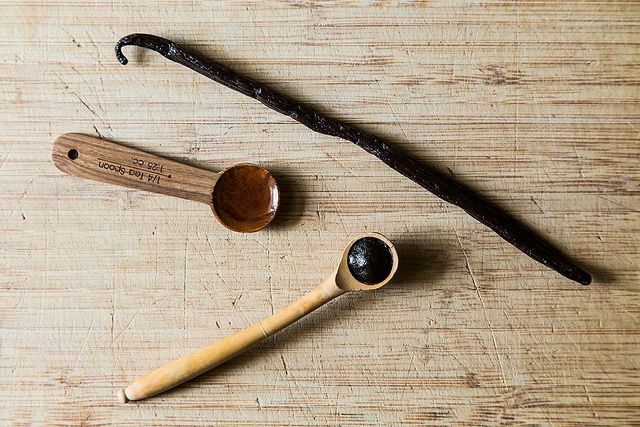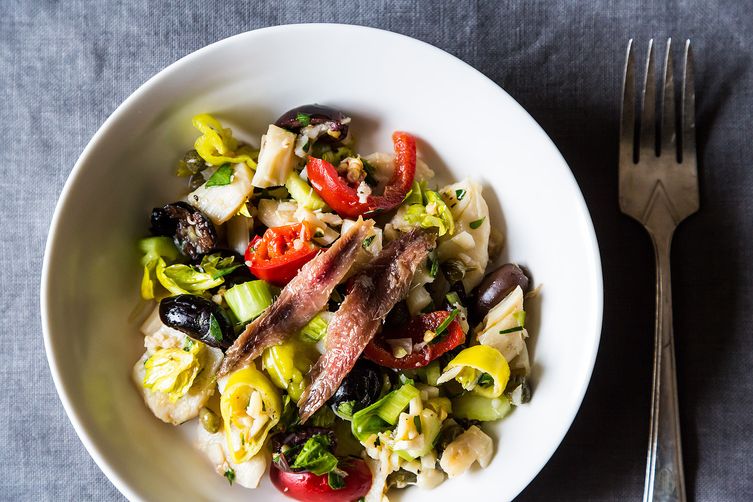Popular on Food52
35 Comments
Bart H.
January 20, 2016
Tone deaf? Screw the rest of the world..$200 is a skinny living for ten days virtually anywhere in America. Only Welfare recipients live better.
Richard
October 26, 2015
There was a cherry crop failure in the USA in 2012 and again this year, 2015.
Jared P.
October 23, 2015
I read an article about a year ago that the European pine nut harvest was damaged by drought, driving the cost up. Add in the costs of labor and...
http://www.bloomberg.com/news/articles/2013-03-01/pine-nuts-rate-foie-gras-prices-as-bugs-to-drought-cut-harvests
http://www.oregonlive.com/cooking/2014/04/pine_nut_sticker_shock_as_pric.html
http://www.bloomberg.com/news/articles/2013-03-01/pine-nuts-rate-foie-gras-prices-as-bugs-to-drought-cut-harvests
http://www.oregonlive.com/cooking/2014/04/pine_nut_sticker_shock_as_pric.html
Amy
October 21, 2015
Loved the article - very practical. Agree with Derek Phillips about the Parmigiano Reggiano. It makes even the simplest of pasta dishes taste extra special. Here's a hint if you love pine nuts: buy them from Costco. They have the best price I've seen anywhere, and far better quality than our own local gourmet market.
Derek P.
October 20, 2015
There is no substitute for Parmigiano-Reggiano in terms of quality, and more importantly TASTE. If you are making a dish that calls for "Parmesan" and you use Parmigiano-Reggiano, your dish will taste VASTLY better. If you have to, at least find some Grana Padano.
trix
October 19, 2015
Might have missed something, either math or english ;-) --
"Parmesan costs $8.99 a pound (or you can get a pre-shredded, pre-packaged 4-ounce container of it for a very reasonable $5.29). (. . .) but nothing compared to the $15.99 a pound that the wedge of Parmigiano-Reggiano. . ."
4oz x 4= 16oz aka, a pound, so $5.29 for 4ox x 4 = $21.16 vs. $8.99 or $15.99 for P-R
Love the article.
"Parmesan costs $8.99 a pound (or you can get a pre-shredded, pre-packaged 4-ounce container of it for a very reasonable $5.29). (. . .) but nothing compared to the $15.99 a pound that the wedge of Parmigiano-Reggiano. . ."
4oz x 4= 16oz aka, a pound, so $5.29 for 4ox x 4 = $21.16 vs. $8.99 or $15.99 for P-R
Love the article.
Michael S.
October 19, 2015
The cultures added to butter aren't the reason why there's more butterfat in European-style cultured butter. It's the laws that determine the butterfat level in butter.
Here in the US, there is a law that states it must be 80% minimum. Same in Europe (CODEX standard), but they EXPECT it to be around 82%, which is why "European-style" has generally higher butterfat than American butter.
Here in the US, there is a law that states it must be 80% minimum. Same in Europe (CODEX standard), but they EXPECT it to be around 82%, which is why "European-style" has generally higher butterfat than American butter.
Ann-Marie D.
October 15, 2015
I realize there are lots of city dwellers, but surely when you´re off to visit your family or others in the suburbs, you must try to sneak into a Costco. As someone already said, huge bags of nuts galore including pinenuts and walnuts are under $20. And they will last you for 1/2 a year or more. Everything is worth buying in small quantities to get those unique flavors that they each give (a tin of anchovies should last you 2-3 dishes) - not every day, but when you want to have good flavor for a good meal.
Lindsay
October 15, 2015
Buying vanilla beans in bulk is a great way to go! In my experience, they're much better quality as well. You can get a lb of them for about $60. That's about 100 beans. Split them with a friend and you're good to go. I store them in a big jar of vodka, so I have vanilla extract too!
Nathalie D.
October 15, 2015
I agree about the dried tomatoes. Making them yourself does take forever and I do wonder how much it costs in terms of the energy used by an oven that is switched on for several hours, albeit on low...
Drew
October 15, 2015
Did you just say that the price difference between Parmesan and Parmigiano-Reggiano comes down to official decrees over naming rights?! Au contraire! Taste them side by side and you will know exactly where that extra money went!
Betsey
October 15, 2015
Oh and World Market has very reasonably priced spices, vanilla beans among them.
Betsey
October 15, 2015
Target's Simply Balanced brand has really cheap dried Montmorency cherries. Like REALLY cheap.
Liane
October 15, 2015
All of these items are available and less expensive at Trader Joes (they may not carry vanilla beans, though). Best store ever
MarieGlobetrotter
October 15, 2015
The price of these items also very per item. I mean crème fraîche, artichoke hearts (which are very popular in France, for example), parmesan and even dried nuts (especially walnuts) really don't cost as much in countries like France and Belgium where I grew up and regularly go back to. The most astonishing thing is dairy products, like milk, yogurt and cheese. So much more expensive here is Canada even though they are basic products (especially milk), not fancy ones that you can go without if you are on a tight budget. So it's also a tax/market thing.You can find mozzarella, mascarpone and ricotta for 2 euros.
freesumpin
October 15, 2015
While I understand exactly what you're talking about, you think prices are high in the USA?
I'm an ex-pat from So Cal and am amazed at the prices here in Australia - very expensive, many items twice or more as much - or more! And where a six-pack of common beer may cost $19 and a fifth of cheap vodka $29!
But then the minimum wage here is above $18/hr, folks are given and encouraged to take 4-6 weeks of vacation time a year (and do!), and medical care is FREE,
So I'll remember the low low prices in the States and take the higher prices here - plus higher social values for individuals here. And listen to the complaints there.
I suppose it all depends on your point of view, eh mate?
I'm an ex-pat from So Cal and am amazed at the prices here in Australia - very expensive, many items twice or more as much - or more! And where a six-pack of common beer may cost $19 and a fifth of cheap vodka $29!
But then the minimum wage here is above $18/hr, folks are given and encouraged to take 4-6 weeks of vacation time a year (and do!), and medical care is FREE,
So I'll remember the low low prices in the States and take the higher prices here - plus higher social values for individuals here. And listen to the complaints there.
I suppose it all depends on your point of view, eh mate?
MarieGlobetrotter
October 15, 2015
Exactly, that's what I meant about this post. It just depends on the country. I'm not sure about prices in the US since I live in Canada but I know that items such as dairy products or alcohol are cheaper in Europe. But certain meats, fish and vegetables are much cheaper (and easier to find) here, it simply depends where you live
Leticia M.
October 15, 2015
Truffles and truffle salt. We have a fantastic local grocer (HEB) that carries them when they're in season at a fairly reasonable price, but understanding the truffle's intricacy in harvesting and importing justifies the cost. I know we have a few farmers in the US whom are working on growing them but until their efforts and product are perfected, I'll pay whatever necessary (or save up for it) to have my expensive little shroom.
Anna D.
October 15, 2015
It's very easy to make your own almond butter. I buy raw almonds from Costco, roast them on a baking sheet and throw them in the food processor. That's it.
sjo
October 14, 2015
I'm with PJ Tipsy. This is an absolutely silly and totally tone deaf column. Two hundred dollars for two days would be a fortune to most of the planet's inhabitants.
Sara I.
October 15, 2015
You make a great point--$200 in two days is a lot of grocery money. Originally I wrote that I had that much with 10 days until my next paycheck. That is far less to spend on groceries and whatever other expenses may arise over a week and a half. I apologize if, in the end. I conveyed tone deafness. That was never my intention.
Betsey
October 15, 2015
This is a blog about food in the Western world. Scolding the author about how she chooses to spend her money is what is tone deaf. GMAFB.
sjo
October 15, 2015
I do apologize for jumping in with unnecessary snark. Even as I was writing I suspected that the $200 was not just for groceries.
Smaug
October 14, 2015
Try Trader Joes for nuts and dried fruit- not that expensive. Almonds are the largest user of water in California, which grows something like 90% of the world's supply, so the drought has really pushed the price up. Walnuts also had some sort of specific problem, don't know what, this season. Bulk bins in nuts are generally replenished from huge, prepackaged bags from the back room which also may have been in storage for a while. Vanilla paste from Sur La Table, which contains seeds, and is more flavorful than any extract. Not cheap, nor is Reggiano, but well worth it even to a cheapskate like me. If I had $200 to last two days, I'd consider myself wealthy- certainly I'd blow for some good cheese.















See what other Food52 readers are saying.